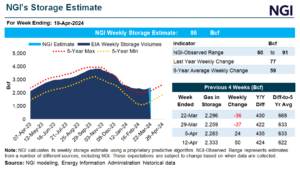E&P | Infrastructure | International | LNG | LNG Insight | NGI All News Access | NGI The Weekly Gas Market Report | Shale Daily
Biden Bans Russian Oil, Natural Gas Imports in ‘Powerful Blow’ Against Putin’s ‘War Machine’
President Biden has banned imports of Russian oil and natural gas in a move that at once compounded already severe sanctions against the Kremlin and amplified the specter of record high energy prices amid a raging war in Ukraine.

“Russian oil will no longer be acceptable at U.S. ports,” the president said in televised remarks Tuesday.
President Biden called it “another powerful blow” against Russian President Putin’s “war machine” and its assault on Ukraine. The U.S. president also cautioned that “defending freedom comes at a cost,” and “it’s going to cost us as well.”
The president was under pressure from leaders on both sides of the political aisle to impose the moratorium. However, the move was weighed for several days before action was taken because it was likely to send already lofty prices even higher. American consumers, by extension, would feel the additional squeeze at gasoline pumps.
AAA said U.S. national average gasoline prices topped $4.17/gallon early Tuesday, up from $3.45 a month earlier and $2.77 a year ago.
International benchmark Brent crude prices topped $130/bbl in Tuesday trading – up about $5 after the ban news broke and up more than 50% since the start of the year.
Even before the Ukraine war started nearly two weeks ago, energy prices were soaring amid constrained global supplies, pushing the U.S. inflation rate in January to a 40-year high.
Russia, the world’s third-largest oil producer after the United States and Saudi Arabia, accounted for about 10% of global supply in 2021, according to International Energy Agency estimates.
Shunning Russian Barrels
In isolation, the impact of a U.S. ban would be minimal, only affecting about 100,000 b/d of Russian crude exports. Russian oil delivered to the United States makes up only 3% of total imports; the U.S. relies almost exclusively on Canada for natural gas imports.
However, if European leaders were to follow the U.S. lead, the continent would be blocking nearly 4.0 million b/d of Russian crude imports, according to Rystad Energy. That could cripple Russia’s energy economy and, at the same time, send prices even higher.
“Although the impact on U.S. supply may be limited, prices are soaring because the ban makes it more of a challenge to trade in Russian oil and more likely that other countries may follow suit,” said Rystad analyst Bjørnar Tonhaugen.
“The market, and U.S. buyers, already started to shun barrels from the Russian region immediately since the outbreak of the war, owing to swift implementation of financial sanctions, restricted commodity financing from lenders or as a result of political decisions to opt away,” he added.
President Biden noted that the United States is a net oil and natural gas exporter. He said many European countries could not immediately follow the United States because they depend on Russian energy.
“We can take this step when others cannot,” the president said. Still, the United States was working with European leaders on a strategy to gradually wean the continent from Russian oil and gas, he said.
Observers said new sources of crude would be needed to offset Russian exports even if only some European Union members support a ban – or severe supply shortages could emerge.
Barclays analyst Amarpreet Singh said “the situation remains highly fluid,” but “a disruption of most Russian seaborne supplies could result in Brent surging beyond $200/bbl in the worst case.”
Backing The Ban
Several industry leaders supported the U.S. ban, at least temporarily.
“I think it makes sense in the short term. It sends a message to Vladimir Putin about what’s going on in Ukraine,” ConocoPhillips CEO Ryan Lance said Tuesday while speaking in Houston at CERAWeek by S&P Global.
That noted, the rest of the world may “stop importing Russian crude oil products as well,” and “this thing could be with us for a while,” he said.
That means the United States needs to concentrate on how energy security helps to define national security, Lance said.
“You need to think about it in the context of more than just a few months…Heaven forbid, this lasts a year or more. We need to start thinking about the implications of that.”
Before the unconventional oil and gas revolution, which helped the United States become nearly energy independent, energy security was paramount, Lance noted. Then “it was like amnesia” and it was put on the back burner until “about two months ago. And now it’s very much back on the agenda.”
American Petroleum Institute (API) CEO Mike Sommers echoed that thinking.
“We support the U.S. government and our allies in their collective efforts against Russia’s unprovoked invasion of Ukraine, and our industry is prepared to comply with the import ban in response to this aggression,” Sommers said.
“The industry has already taken significant and meaningful steps to unwind relationships, both with respect to assets in Russia, as well as imports of Russian crude oil and refined products,” he added. “We share the goal of reducing reliance on foreign energy sources and urge policymakers to advance American energy leadership and expand domestic production to counter Russia’s influence in global energy markets.”
U.S., OPEC-Plus To The Rescue?
The United States and allied countries have pledged to release strategic oil reserves of 60 million bbl, Biden noted. Still, that would only offset lost Russian exports for a few weeks. It would take months more for Lower 48 producers to ramp up notably to help fuel global needs. U.S. output has been flat early this year around 11.6 million b/d.
Major producers that partner with Saudi Arabia and make up OPEC-plus have vowed to increase output by 400,000 b/d this year. OPEC members have even more capacity, but aging infrastructure and geopolitical strife have prevented the cartel from reaching targets so far. This calls into question their ability to address Russian-created challenges, adding upward pressure on prices.
OPEC-plus holds about 4.0 million b/d in spare crude capacity, “but there are few signs that the Middle East producers are opening the taps, at least not yet,” Tonhaugen said. Absent additional OPEC-plus response, “the most significant potential oil supply shortage since the 1990 Gulf War (when oil prices doubled) could be upon us.”
As such, “oil prices must rise to destroy sufficient demand and incentivize a supply response through higher activity – both of which will happen with a time lag of several months – to rebalance the market at a higher price,” Tonhaugen said.
“How high oil prices will need to go depends primarily on how much and for how long the market will need to shun export barrels from Russia and whether other buyers, such as China, will step in to increase purchases of oil from Russia,” he added.
Carolyn Davis contributed to this report.
© 2024 Natural Gas Intelligence. All rights reserved.
ISSN © 1532-1231 | ISSN © 2577-9877 | ISSN © 1532-1266 | ISSN © 2158-8023 |


